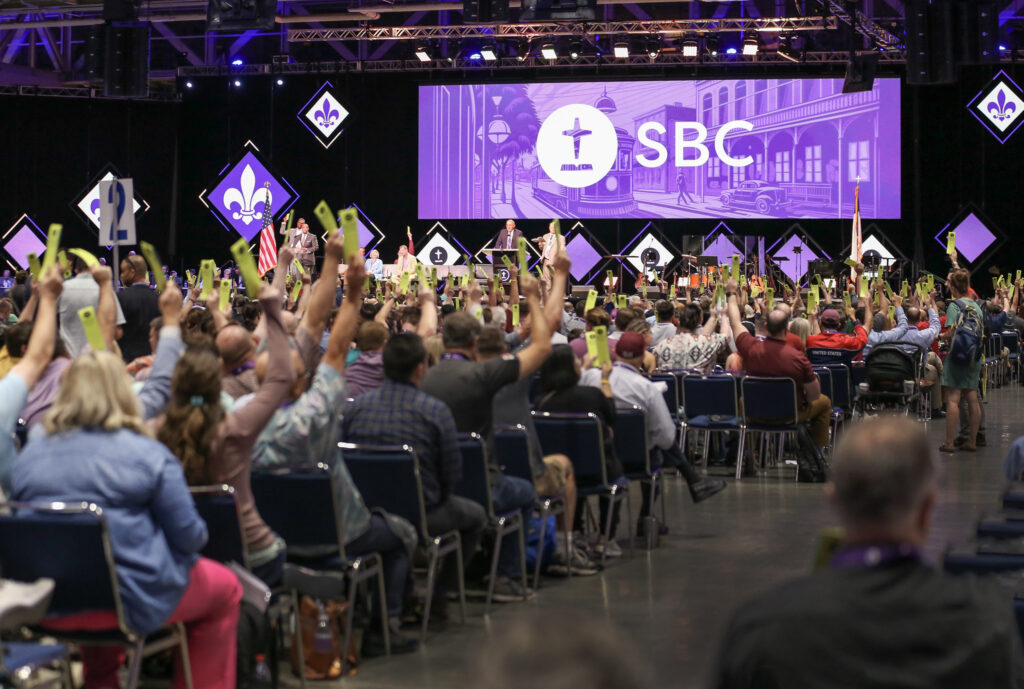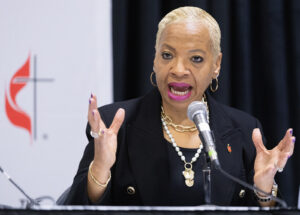

Southern Baptists are facing decisions that could represent a significant shift in terms of who we are and how we cooperate. This change in our self-understanding has often gone unnoticed, as other issues in the past 10 years have been the focal point of conversation: reckoning with racism, rooting out sexual abuse and the role of women in ministry. It’s possible that many Southern Baptists – seeking to provide a firm and clear answer on these questions – may not realize the extent of the implications in other areas. I hope this article will bring to the surface some challenges that, so far, have not been at the center of conversation.
The climate of the SBC has become more contentious in recent years (though more online, I think, than in person), making deliberation difficult. Tribal impulses lead many to impugn the motives of brothers and sisters who have concerns about the current direction or who raise good questions about the unintended consequences of certain decisions. I don’t presume I can avoid being interpreted in polarizing ways, but I’m going to do my best to try to delineate seven considerations. Wherever you land, please assume the best of intentions.
It’s not my place in this article to advocate a particular course of action. I don’t presume to tell Southern Baptists how to vote on specific issues. In His providence, the Lord planted me in Southern Baptist fields, and it’s here I hope to labor in service to the good churches and great people of this Convention. One way to serve in this moment is to help Southern Baptists gathering in Indianapolis next year to think carefully through a variety of issues before casting a ballot. This article is lengthy because it is important to consider these seven elements together.
- A Better Analogy for Cooperation
Before getting into the nitty gritty of today’s controversies, I’d like to alter an analogy we often use when we talk about the Southern Baptist Convention. People often describe the SBC as a big ship. Some say it takes a long time to turn it in one direction or another. Others talk about taking the ship. Still others claim the ship is drifting this way or that way, heading for disaster. Some say we’re drifting into liberalism, while others claim we’re drifting into fundamentalism.
The ship analogy only works if you’re thinking about the entities of the SBC (and even then, we’re talking multiple ships, not just one), but if we truly believe the SBC headquarters is the local church and not the Convention offices in Nashville, then we’re not really a big ship. We’re more like a fleet of little boats, all going in roughly the same direction, with a common purpose and mission. (Picture the boats of all sizes and types rescuing the men stranded on the beaches of Dunkirk!) The SBC is more like a fleet than a ship. Some of the boats are bigger than others. Most are relatively small. Some of the boats are out in front, leading. Some boats join up with others in closer partnership, creating a mini fleet of sorts. Every year, some of the boats will be launched, and others will sink. A good number of boats out on the seas will find the fleet and join with us. Others may discover a different fleet and leave.
It’s better to think of the SBC more as a fleet than as a cruise liner or battleship. That’s why, when I get asked if Southern Baptists are drifting left or drifting right, I say, “Yes.” At any given time, some of the boats are veering off to the left, and others to the right. And in a convention with nearly 50,000 churches, you can always find examples of churches or pastors who will confirm whatever narrative you believe about the SBC’s direction. (Especially in an era when so many services are streamed and so much information is available online.)
We should be careful not to extrapolate from the boats veering off to the left or to the right a conclusion about the Convention as a whole. Beware of Grand Narratives. They’re popular on social media, but they don’t give you an accurate view of reality.
- The Bottom-Up Structure of the SBC
You’ve probably been told the SBC is not a denomination. We are a convention of independent, autonomous churches that cooperate in a common mission. Unlike denominations, we are not structured in a top-down fashion, but as a bottom-up fellowship.
Imagine our cooperation in concentric circles, starting at the local church level, moving upward through associations, then state conventions, and finally the national gathering. Historically, Southern Baptist cooperation has been closest at the associational level – regional gatherings of churches in a particular place united not only by their desire to cooperate in missions but by their proximity to one another. The state convention level engaged a broader gathering of churches. The national convention level is the biggest circle. This structure differentiates us from denominations such as the Presbyterians or Anglicans, for example, who enforce discipline from the top down, complete with presbyteries, dioceses, consistories, etc.
To put it simply, the SBC has been structured to serve independent, autonomous churches that agree on enough things to see wider cooperation as worthwhile. Ideally, membership in the SBC extends the ministry of the local church, which is why it’s often said, “We can do more together than we can apart.”
- The Place of The Baptist Faith and Message
We are less than two years away from the 100th anniversary of the original Baptist Faith and Message – the first consensus statement of faith adopted Convention-wide. The historic nature of the 1925 annual meeting should not make us think Southern Baptists were previously opposed to creeds and confessions. “No creed but the Bible” was always more of a Restorationist slogan (championed by men such as Alexander Campbell) than a Baptist one.
Throughout our history and across the landscape of associations, seminaries and state conventions, Baptists have affirmed the ecumenical creeds and have adopted various confessions with Reformational and Baptist distinctives. (The New Hampshire Confession of Faith was the most common precursor to the Baptist Faith and Message, but there was also the Abstract of Principles, which still guides the doctrine of two of our seminaries.) It is not a Baptist distinctive to resist or oppose clear doctrinal boundaries.
At the same time, we’ve seen a shift in the last century, speeding up considerably in the past 20 years, toward making the BF&M a binding document in all areas of Southern Baptist life. Since 2000, the BF&M has shifted from being a general consensus statement to becoming a requirement for most roles in our entities, and today we’re witnessing a further shift toward the BF&M becoming a confession that establishes the boundaries of cooperating churches.
This shift has happened without fanfare. Many pastors today are surprised to discover that compliance with the BF&M is not a requirement for cooperation as a Southern Baptist church. The assumption among many is that the BF&M is confessionally binding on our churches, and when a church demonstrates non-compliance in some way, the decision to disfellowship is simple, an open and shut case.
The reality is more complicated. Falling outside the parameters of the BF&M has never meant falling outside the cooperative circle of Southern Baptist fellowship. We’ve locked arms with churches that don’t line up with the BF&M on every point but who express a desire to cooperate in international missions, church planting and seminary education.
Not surprisingly, across the Convention, we find churches with a variety of views, some that fall outside the parameters of our consensus statement of faith.
- The biggest challenge is the practice of open communion – sharing the table with Christians visiting from other denominations who were sprinkled as infants. A stream of Baptists going all the way back to John Bunyan have advocated this position, but until recently it was a minority view in the SBC. It may now be the majority practice.
- In recent years, some Baptist churches have taken issue with the BF&M on religious liberty, advocating for policies that line up more closely with older Christendom arrangements between church and state or lobbying the government to disallow the building of Islamic mosques or Hindu temples.
- A striking number of Southern Baptist churches fall outside the BF&M in terms of polity. In many contexts, the deacons function in the place of authority over the pastor. Other churches are run by committees staffed with laypeople. Some churches have a central board. More than a few have a church council. Look closely enough and you’ll find a few churches aren’t just “elder-led” but “elder-ruled” (and this falls outside the bounds of congregationalism).
I could multiply the examples, but these are enough to show that, historically, the Convention has not required strict adherence to our consensus statement – granting a measure of freedom around the edges – because we want as many churches as possible cooperating in getting the Gospel to the nations. (This also explains why, after the adoption of the BF&M 2000, which added a statement about only qualified men serving as pastors, not one of the hundreds of churches with women serving in senior pastor roles was disfellowshipped at the national level. Again, the BF&M was intended as a consensus statement, not a confession required for cooperation.)
In the past three decades, cultural changes and challenges have made some of our loose-knit requirements for cooperation seem too thin. When revisionist theologies of sexuality gained a foothold in the 1990s, the Convention made it clear in the constitution that a church could not reject the BF&M’s position on homosexuality and remain in friendly cooperation. The historic Christian teaching on sexuality was non-negotiable. There would be no “agree-to-disagree” posture. No Southern Baptist church could remain in good standing while recommending a wholesale departure from the Scriptures and the Church’s unchanging witness on marriage and sexuality.
In the past decade, the Convention added two more reasons for disfellowship: a pattern of unrepentant racial discrimination and an indifference to sexual abuse. As egregious examples of racism and abuse came to light, the Convention declared, loudly, that there would be zero tolerance in terms of friendly cooperation. The constitution reflected the tightening of parameters.
- The SBC: Comfortably Complementarian
In the past five years, the SBC has been debating what it means to be complementarian, as well as the level of uniformity should we expect among churches in defining and applying these convictions. This is the presenting issue facing the Convention right now. I say presenting because this debate is only one aspect of the broader discussion of what it means to be Southern Baptist and how the BF&M fits into that identity.
There are two conflicting trends that signal different stories and confuse the issue. Let’s look first at the question of women serving as senior pastors. At the time the BF&M 2000 was adopted, there were likely a few hundred churches in the SBC with women serving as senior pastors. Although these churches were not disfellowshipped (I explained above the reason why – the BF&M was not seen as binding on churches for cooperation), most of them have since self-selected out of the SBC. Some joined the Cooperative Baptist Fellowship. Others became dually aligned. Many stayed within the SBC and eventually reestablished complementarian practice. If you were to tally the number of churches in the SBC with women serving as senior or sole pastor, there’s no question you’d see a sharp decline since the late 1990s.
But there’s a second trend. In the 1990s and 2000s, more and more churches began giving the title “pastor” to staff positions, even when the office of pastor was not in view. Ministers of education became associate pastors of education, directors of children’s ministry became children’s pastors, etc. (I’ve even come across titles like “pastor for communications and technology,” or “pastor for media development.”) As the number of pastor titles has increased so has confusion about the role of pastor and what it represents. If you were to tally the number of churches in the SBC with women serving on a church staff with the title of “pastor,” there’s no question you’d see an increase in the past 20 years. Likewise, many men who don’t fit the biblical qualifications for pastor or truly hold the office have been given the title.
To sum up: The number of women serving as senior pastors in the SBC has been falling, while the number of women serving in staff roles as a “pastor” of some sort has been rising. It’s important to look at these two trends together so we can get a clearer picture of why there’s been confusion and avoid simplistic narratives about women in the SBC.
(An interesting side note: when I was doing mission work in Romania as a college student, I gave out prayer cards with the title “youth pastor.” I was 19 years old, unmarried and not yet licensed or ordained. The Romanian pastor of the village church was wise to guard the office of pastor and told me I was serving in a ministerial role but not with pastoral authority. Another side note: unlike the BF&M, these Romanian Baptists made a distinction between “pastor” and “presbyter”/ “elder,” but I digress. Baptist life is messy!)
Based on the votes in New Orleans, it’s clear Southern Baptists are comfortably complementarian. Since 2000, the Convention has grown more settled on this question, not less. How else do we account for the fact that, for the first time in our history, we’ve made complementarianism a test of fellowship at the national level? What’s more, recent decisions of the SBC have ruled out even the “broad, gift-based, soft complementarian” position that distinguishes between the office of elder and the gift of pastoring (as articulated by evangelical leaders like John Stott and J.I. Packer). It is clear the SBC is comfortably complementarian.
But what does this development mean for our constitution and the structure of the SBC moving forward? What should be our next steps? Related to these questions are bigger ones: Who are we? How do we define our cooperation? Where does the BF&M fit into our identity? And how do we enforce the decisions we make?
These are the questions we must consider. What level of uniformity do we expect among our churches in relation to polity? In response to recent decisions, many churches might change their nomenclature (the “pastor” title becoming “minister” or “director”), but there may be some churches that don’t. Will we disfellowship a church with a woman serving as “women’s ministry pastor” or “children’s pastor”? How will we handle churches run by a board, with men and women?
There are more complexities to consider. Earlier this year, I visited a Southern Baptist church in the North, led by a plurality of all-male pastors, and yet women performed baptisms. In many, if not most of our churches, baptizing is an action performed by pastors. Not this one. What will happen when one church disagrees with another church’s understanding of “office” and “function” of pastor?
- Inverting the Structure of the SBC
Until now, the Southern Baptist Convention has been fine with a considerable amount of messiness for the sake of the mission. We’ve not made uniformity on these matters a requirement for cooperation, in part because of what we’d need to create to enforce it. We simply do not have a structure designed to handle hundreds of investigations of churches reported to be out of line with the BF&M. To deal with all the churches that could be reported for irregularities, we would need to either expand the SBC Credentials Committee or develop an investigative body and judicial apparatus to make suggestions for messengers to vote on.
In short, it would take the inversion of our current structure to make this happen. The bottom-up concentric circles that have defined Baptist cooperation (associational, state and national) would be flipped top-down. We would need to build up a tribunal of sorts – some kind of judicial apparatus – invested with the authority to investigate churches. Based on the current requirements for scheduling our annual meeting, we could easily find ourselves hearing appeals all day (or multiple days) every summer. What’s more, if state conventions and local associations (each of which is autonomous) do not adopt the same requirements, we could wind up with a growing number of churches that are “SBC” at the state and associational level but not at the national. It would likewise become nearly impossible to enact amendments and revisions to the BF&M in the future, since any changes would be used to automatically exclude churches who agree with the confession today but may not be on board with the recommended adjustments of tomorrow.
In every healthy movement of churches, some will emphasize missionary zeal (“Let’s make sure we get the truth to everyone!”) and others will emphasize doctrinal clarity (“Let’s make sure what gets to everyone is the truth!”) We need both emphases so that mission doesn’t slide into syncretism and doctrine doesn’t slide into sectarianism. It may be that, because of the cultural issues Southern Baptists face today, the majority will decide it best to continue along the path of making the BF&M a binding document for cooperation in the future.
My heart is simply to be sure messengers know the structural ramifications of making such a move so that everyone has eyes wide open regarding the possible implications.
- Why is anyone SBC?
As we debate and discuss the best path forward, I do think it wise to ask the question: Why is anyone SBC? Why would other boats out there on the seas want to join our fleet? Who are we? Where are we going?
Recently, a pastor in a strong, supporting church gave me this answer: We cooperate with the SBC because the SBC extends our Gospel ministry. Through international missions, North American church planting, disaster relief efforts, chaplaincy, children’s homes, publishing, D.C. lobbying, seminary education, etc. When the SBC extends the ministry of the local church, the saying that we can do more together than apart is shown to be true.
But we should also consider why a church would choose not to align with the SBC. The same pastor told me that when he and his church feel their SBC affiliation constricts rather than extends their ministry, it’s only a matter of time before the question will be raised: Why stay? The more the typical Southern Baptist pastor or church expends sideways energy defending themselves or the SBC when they would rather be focused on mission and ministry, the more likely we are to see Southern Baptist churches – even those that agree with every jot and tittle of the BF&M – quietly disengage or find another fleet.
These questions go well beyond the current controversies. They are questions that get to the heart of who we have been and who we want to be. I hope Southern Baptists will consider these matters as we deliberate together.
- A Word about Women
Finally, it would be a missed opportunity if I didn’t mention the absolute indispensability of women in the mission of God and the ministry of our churches. In all these conversations, it would be a travesty if we were to settle for a pseudo-complementarianism that results in women being underutilized – to be so afraid of permitting what the Bible forbids we wind up forbidding what the Bible mandates. Every part of the body matters, and every part is to work together in synergy.
If we are to fulfill the Great Commission and flourish in our unique and distinctive callings, we must cultivate a culture that celebrates the ministry of women in the church, as well as the mission impact of women in the neighborhood, workplace, and community. God has blessed the SBC with one of the greatest mission forces in the world. Who we are as a Convention, and how we partner – men and women together—matters for the advancement of God’s kingdom. May He give us grace and wisdom in the days ahead.
















